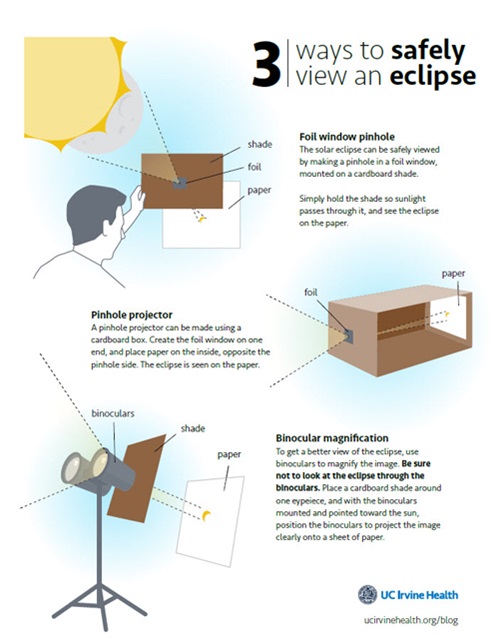Viewing the eclipse without eye protection can lead to irreversible damage.
On Aug. 21, when the moon passes in front of the sun during “The Great American Eclipse,” Southern Californians may be in even more danger of damaging their eyesight by looking at the partial eclipse than if they stared at the full sun.
That’s because most people naturally avert their eyes if they happen to look at the sun. But with a partial eclipse like we’ll experience in the Southland from 9:05 a.m. to 11:44 a.m., some may feel a false sense of comfort that it’s safe to look at the sun since it’s partially blocked by the moon and is such a talked-about astronomic phenomenon.
“Normal people may want to stare at an eclipse,” explains Dr. Baruch Kuppermann, the newly appointed chair of the UCI Health Department of Ophthalmology and professor of ophthalmology and biomedical engineering, “so the risk is much greater during an eclipse if you’re not properly protected.”
How intense light damages eyes
Damage can occur in two ways:
- To the deep layers of the retina
- To the cornea and lens in the front of the eye
The human eye is a complex and delicate organ whose central retina (or macula) is composed of 10 layers, explains Kuppermann.
The intense light of the sun sparks a series of chemical reactions that can damage the photoreceptor cells in the deepest layers of the retina — the ones that absorb light and convert it into electrical signals, as well as the pigmented layer behind that. Severe exposure can damage the entire retina.
“The result can be a blind spot in the very center of your vision,” says Kuppermann, “which would make it nearly impossible for you to read comfortably, drive or see people’s faces even with the good peripheral vision you’re likely to retain.”
Doctors have yet to discover how to repair retinal damage caused by sun gazing, although partial or full recovery of inflammation surrounding the burned area may occur. Fortunately, secondary damage to the cornea and lens can often be fixed with surgery.
What you need to view the eclipse
Whether you’re in Southern California where the sun is partially blocked, or in the 70-mile wide path from Oregon to South Carolina where the eclipse will be complete, special protection is necessary to protect your eyes. Normal sunglasses — even very dark ones — won’t do the job.
- You’ll need glasses that use neutral density filters to reduce the amount of light going into your eyes. Solar eclipse glasses should be ISO 12312-2-certified.
- Welder’s glass of at least No. 14 can also be used.
- Telescopes will actually magnify the retinal burn unless equipped with proper filters.
- Visit NASA’s Eclipse 101 website for details of how to safely view the eclipse.
(Kuppermann cautions that this is not intended to be medical advice and that some people may experience damage even when using recommended protection if they have undiscovered ocular disease.)
Those in the path where the moon will move directly in front of the sun for a total eclipse may be able to view it more safely for that brief period— 2 minutes, 40 seconds — while the sun is completely blocked. “But they should still take care to prevent damage by wearing protective sunglasses during the complete eclipse phase and as well as during the transition into and out of 100 percent eclipse,” says Kuppermann.
“This eclipse is a rare, spectacular experience,” Kuppermann says, “but please don’t hurt yourself — please be cautious.”
How to view the eclipse safely
You don't have to miss the eclipse. Download a copy of this PDF ›

Related stories



